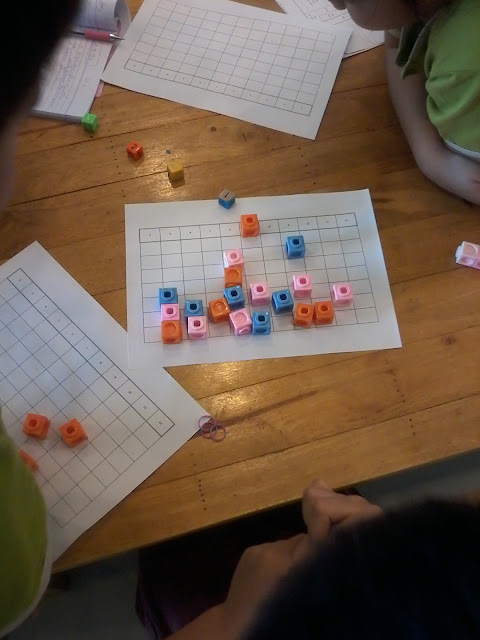First Grade
Warm-upAs a very quick warm-up, I asked the kids about days of the week: for example, what day follows Monday? what day precedes Friday? This was more challenging than I expected and I think need to practice.
First Game: number line squeeze
We made a number line with integers marked from 0 to 20. To start the game, I think of an integer in this range. Then, the kids take turns guessing. With each incorrect guess, I will give them an extra clue: "my number is smaller than [the number they just guessed]" or "[guess] is larger than my number," etc. When they get this clue, I had them draw a bracket on their number line, ( when their guess was too small and ) when their guess was too large.
This is a quick game to help encourage their familiarity with the number line and some logical inferences. For example: if they already know that 5 is too small, what do they know about 3?
We also took turns where they picked the secret number.
There are a couple of extensions we can play in the future:
- Allow them to ask about ranges, for example: is the number between 5 and 11?
- Ask "or" questions: is the number smaller than 3 or larger than 15?
- Ask calculations: is the number equal to 3+4?
Don't make a triangle
Our second game was a fun one from Math4Love. Don't make a triangle. The idea is simple: draw a bunch of starting dots in black (we used 6). Each player has a chosen color takes turns connecting the original dots. You lose if you form a triangle with all sides of your own color.
This was a fun game which, as you can see, leads to some pretty pictures. Especially when we play this back to back with tic-tac-toe, it leads to an interesting question: can the game end in a tie? Why or why not? Subtle stuff for first grade.
2nd and 3rd grades
Our game this week was related to Dice Miner from last week and comes from friends at Logic Mills in Singapore. As with Dice Miner, players start with 11 tokens of the same color and we play on a grid with columns labeled 2 through 12. This time, though, the grid has 8 rows, 3 players use the same grid at one time, and we had three extra markers (we used loom bands).On each player's turn, they throw 4 dice, then choose to group them into two sets of two. They take the sum of each set and place a temporary/common marker (the loom bands) in the columns. After marking their territory with the temporary markers, the player has a choice: throw again or claim their progress by placing one of their tokens on the spaces they've reached. If they throw and can't place a temporary marker (there are only 3 at a time!) then they lose all of their progress for the turn.
When a player has reached the top row of a column, they claim that number. The first player to claim 3 numbers wins.
For those who like this type of classification, the game has a territory conquest objective played through a race-against-each-other mechanic.
Here are some pictures, mid-play.
In this picture, orange has capture column 7. Now, any two dice that sum to 7 are safe for all the players and orange is 1/3rd of the way to victory.
A bit later, we see that blue is close to claiming 9 and pink is close to claiming 6, but orange is close behind there.
In a different group, white is close to claiming column 8, but a good turn from yellow could disrupt that plan.




No comments:
Post a Comment